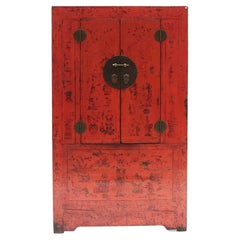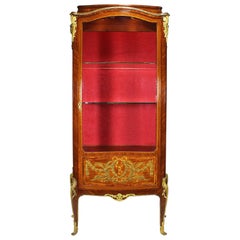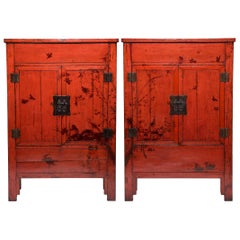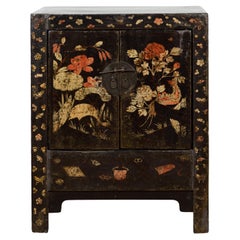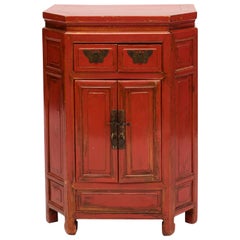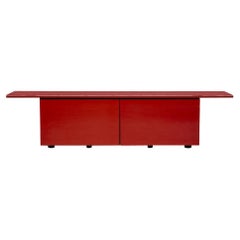Hardwood Cabinets
Color: Red
Material: Hardwood
19th Century Chinese Red Lacquer Cabinet with Gilt Decoration
Located in Dallas, TX
A Chinese red lacquered cabinet with gilt decoration from the late 19th century.
This cabinet is a great size and is highly decorative and useful with a lot of hidden storage space.
Category
Late 19th Century Chinese Chinoiserie Antique Hardwood Cabinets
Materials
Bronze
Qing Dynasty Lacquer Cabinet With Decorations
Located in Kastrup, DK
Chinese cabinet i red lacquer with remains of decorations, which gives the cabinet a beautiful patina. Black lacquer on the sides of the cabinet.
Features double doors, beautifully a...
Category
Early 19th Century Chinese Qing Antique Hardwood Cabinets
Materials
Brass
19th-20th Century Marquetry and Gilt-Bronze Mounted, François Linke Atrributed
Located in Los Angeles, CA
A fine French 19th-20th century kingwood and tulipwood marquetry and gilt-bronze mounted vitrine, in the manner of François Linke (1855-1946). The slender single door display cabinet with a red-velvet backing and bowed glass panels surmounted with acanthus and floral gilt-bronze mounts in the style of Léon Messagé (French, 1842-1901), the serpentine shaped front door with an ornate marquetry and ink colored panel depicting wreaths, ribbons and tied acantus leaves, all raised on four cabriolet legs ending with gilt-bronze paw-feet, Paris, circa 1900.
Linke was born on 17 June 1855 in the small village of Pankraz, in what is now the Czech Republic. Records show that Linke served an apprenticeship with the master cabinet maker, Neumann, which he completed in 1877. Linke’s work book or Arbeits-Buch records that he was in Vienna from July 1872 to October 1873 at the time of the International Exhibition held there in 1873.
He subsequently travelled to Prague, Budapest & Weimar before finally arriving in Paris in 1875. It is documented that he obtained employment with an unknown German cabinetmaker in Paris, and stylistic similarities, photographs and geographical proximity have led some to suggest that Emmanuel Zwiener was the most likely candidate. After a period back in his home town of Pankratz, he returned once and for all to Paris in 1877. In 1878 Paris hosted the third great International Exhibition, a remarkable success for a country ravaged by war only seven years earlier. It is known that the fledgling Linke workshops were active in the Faubourg St. Antoine as early as 1881, during this time he supplied furniture for other more established makers such as Jansen and Krieger.
By 1889 another World’s Fair, as they were often referred to in America, took place in Paris. Monsieur Eiffel erected what has become the most iconic building in Paris for the exhibition and the atmosphere of wealth and confidence may well have encouraged Linke to think that he could contribute an important part to the next great exhibition. As early as 1892 this was decreed to take place at the end of the century, in an attempt to pre-empt Berlin from staging the last great show of the century.
In 1892, Victor Champier (fr) one of the commissioners for the 1900 Paris Fair had appealed, “Create in the manner of the masters, do not copy what they have made”. It was an appeal against mere reproduction and Linke rose to this challenge in an unparalleled way with his unique display that was to include the Grand Bureau.
Determined to outshine the competition at the Exhibition, Linke had set about creating the most ambitious pieces he could envisage, and more extravagant than had ever been displayed before. The items he exhibited marked a transition from the historicist interpretation of Louis XV and Louis XVI styles, an interpretation that was the mainstay of his nearest rivals, to something startlingly new and vital in its immediacy. [6] Together with Léon Messagé he developed a new style for the 1900 Exhibition that paid homage to the Louis XV rococo in the fluidity of its approach, but an approach fused with the lively flowing lines of the contemporary and progressive 'art nouveau'. The Art Journal reported in 1900 on Linke's stand:
"The work of M. Linke ... was an example of what can be done by seeking inspiration amongst the classic examples of Louis XV and XVI without in any great sense copying these great works. M. Linke's work was original in the true sense of the word, and as such commended itself to the intelligent seeker after the really artistic things of the Exhibition. Wonderful talent was employed in producing the magnificent pieces of furniture displayed".
Linke's stand would have appeared refreshingly new to contemporary onlookers, the traditional designs of the eighteenth century melting seamlessly into an exuberant naturalism. The 'Revue' described Linke's style as 'entièrement nouveaux' and noted "This opinion is universally accepted. Linke's stand is the biggest show in the history of art furniture in the year 1900". It is perhaps the most extraordinary and remarkable aspect of Linke’s personal history that he produced such expensive and luxurious furniture of exquisite quality for the 1900 exhibition without any commission or any potential buyer in mind. [9] At a time when other more established furniture businesses such as those of Beurdeley and Dasson were closing down, he made a huge investment in his stand and the furniture he supplied for it. Linke recognised that to move his business forward he needed to appeal to a more International clientele and the new emerging rich who were at this time amassing fortunes on an unprecedented scale. For this reason he gambled everything he had on his display for the 1900 exhibition. Had this not succeeded he would almost certainly have succumbed to bankruptcy. Linke’s notebook records visitors to his stand from England, Europe, the Americas, Egypt and Japan and including; the King of Sweden, three visits from the King of Belgium, Prince Radziwill, the Prince d’Arenberg, the Comte Alberic du Chastel, Miss Anna May Gould, the American heiress, distinguished furniture makers and the President of France Emile Loubet.
This risky endeavour was a resounding success, and with his reputation established, La Maison Linke became the pre-eminent furniture house until outset of the Second World War. The technical brilliance of his work and the artistic change that it represented was never to be repeated. His showrooms expanded into prestigious premises in Paris, in the Place Vendôme as well as the Faubourg St. Antoine where his workshop had been established. He embarked on many important commissions in the years up to the outbreak of the First World War, making and designing furniture for leading international industrialists and bankers. After the 1914-1918 World War, Linke undertook the extraordinary commission to furnish the Ras al-Tin Palace in Alexandria for King Fuad of Egypt, possibly the largest single furniture commission ever conceived, eclipsing even Versailles. Linke flourished and remained active until the middle years of the 1930s and died in 1946
Léon Messagé (1842-1901) was a French sculptor, best known for his sculptural collaboration with François Linke for the 1900 Paris Exposition Universelle. Messagé was also responsible for much of the design and creative work for Roux et Brunet...
Category
Early 1900s French Louis XV Antique Hardwood Cabinets
Materials
Bronze
Pair of Chinese Red Lacquer Cabinets with Birds in Flight, c. 1850
Located in Chicago, IL
This pair of early 19th century red lacquer cabinets is an extraordinary find. When placed beside each other, what remains of the finely-painted decoration comes together to form a s...
Category
Mid-19th Century Chinese Qing Antique Hardwood Cabinets
Materials
Elm
Related Items
Gilt Bronze Mounted Vitrine by François Linke
Located in Ciudad Autónoma Buenos Aires, C
Louis XV style vitrine by François Linke (1855 - 1946) Made of gilt bronze mounted wood, with a violet breccia marble top, front and beveled glass pa...
Category
19th Century French Louis XV Antique Hardwood Cabinets
Materials
Bronze
Chinese Late Qing Dynasty Lacquered Bedside Cabinet with Hand Painted Décor
Located in Yonkers, NY
A Chinese late Qing Dynasty period dark brown lacquered bedside cabinet from the early 20th century, with hand painted cream and orange dragon, bird and floral motifs, two doors, traditional bronze medallion hardware, straight legs, carved apron and weathered patina. This Chinese late Qing Dynasty period dark brown lacquered bedside cabinet from the early 20th century is a captivating blend of artistry, history, and craftsmanship. The cabinet boasts a rich, dark brown lacquer finish, imbuing it with a sense of timeless elegance and sophistication. The exquisite hand-painted cream and orange dragon, bird, and floral motifs dance across the cabinet's surface, adding a layer of intrigue to this remarkable piece.
The cabinet features two doors, fitted with traditional bronze round medallion hardware that complements the dark lacquer and painted motifs. The doors open to reveal convenient storage space, perfect for housing books, personal items, or any other bedside essentials. The cabinet stands on four straight legs, providing a sturdy and balanced foundation, while the simply carved apron completes the ensemble beautifully.
A weathered patina graces the surface of this early 20th-century Chinese bedside...
Category
Early 20th Century Chinese Qing Hardwood Cabinets
Materials
Bronze
H 33 in W 26 in D 17.5 in
Chinese Qing Dynasty 19th Century Side Cabinet with Distressed Black Lacquer
Located in Yonkers, NY
A Chinese Qing Dynasty period side cabinet from the 19th century with double doors, distressed black lacquer and brass hardware. Created in China during the Qing Dynasty in the 19th ...
Category
19th Century Chinese Qing Antique Hardwood Cabinets
Materials
Brass
H 21 in W 15.5 in D 8.75 in
Chinese Qing Dynasty 19th Century Shanxi Cabinet with Original Black Lacquer
Located in Yonkers, NY
A Chinese Qing Dynasty period Shanxi cabinet from the 19th century, with original lacquer. Created in the North-Eastern province of Shanxi during the Qi...
Category
19th Century Chinese Qing Antique Hardwood Cabinets
Materials
Wood
Chinese Red Painted/Lacquered Cabinet With Flowers, Circa 1820
Located in Round Top, TX
Antique Chinese Red Painted/Lacquered Cabinet. This beautiful red cabinet has lovely flowers and pomegranates displayed on the panels in black and highlighted in gold. The unique pan...
Category
19th Century Chinese Antique Hardwood Cabinets
Materials
Wood, Paint, Lacquer
Chinese Qing Dynasty 19th Century Red Lacquer Cabinet with Painted Fruit Baskets
Located in Yonkers, NY
A Chinese Qing Dynasty period small red lacquer cabinet from the 19th century, with painted fruit baskets and brass hardware. Created in China during the Qing Dynasty, this small cabinet features a rectangular top sitting above two doors and three drawers. The doors, fitted with brass hardware and ornate pulls, are painted with fruit baskets while the three drawers below complete the ensemble beautifully. Boasting a nicely weathered patina, this red lacquer Chinese Qing cabinet...
Category
19th Century Chinese Qing Antique Hardwood Cabinets
Materials
Brass
H 23.5 in W 24.5 in D 12.5 in
19th Century French Vitrine of Kingwood and Gilt Bronze Mounts
Located in London, GB
A fine vitrine in the manner of Francois Linke
Constructed in kingwood, with gilt bronze mounts, in the Louis XVI Transitional style; rising from bronze foliate sabots, with gent...
Category
19th Century French Louis XVI Antique Hardwood Cabinets
Materials
Marble, Bronze
Chinese Qing Dynasty 19th Century Red Lacquer Cabinet with Chinoiserie Décor
Located in Yonkers, NY
A Chinese Qing dynasty period red lacquer compound cabinet from the 19th century, with gilded Chinoiserie décor, drawers and carved apron....
Category
19th Century Chinese Qing Antique Hardwood Cabinets
Materials
Wood
H 95.5 in W 43 in D 19.75 in
Chinese Qing Dynasty 19th Century Red Lacquer Cabinet with Doors and Drawers
Located in Yonkers, NY
A small Chinese Qing Dynasty period red lacquer side cabinet from the 19th century, with double doors, two drawers and brass hardware. Created in China during the Qing Dynasty in the...
Category
19th Century Chinese Qing Antique Hardwood Cabinets
Materials
Brass
H 29.5 in W 25 in D 14.75 in
Chinese Ming-Style Tapered Cabinet with Original Red Lacquer
Located in Kastrup, DK
Mid-19th century Chinese tapered cabinet. Original red lacquer.
Pair of doors fitted with bronze lock opens to reveal a shelved interior, fitt...
Category
Early 19th Century Chinese Ming Antique Hardwood Cabinets
Materials
Brass
Chinese Qing Dynasty 19th Century Red Lacquer Cabinet with Butterfly Décor
Located in Yonkers, NY
A Chinese Qing Dynasty period red lacquered cabinet from the 19th century with four doors, two drawers and hand-painted butterfly and foliage motifs. Created in China during the Qing...
Category
19th Century Chinese Qing Antique Hardwood Cabinets
Materials
Metal
H 71 in W 38 in D 18.75 in
Chinese Qing Dynasty Side Cabinet with Original Lacquer and Faint Painted Décor
Located in Yonkers, NY
A Chinese Qing Dynasty period side cabinet from the 19th century, with original lacquer and faint painted décor. Created in China during the Qing Dynasty period, this side cabinet features a linear silhouette beautifully complimented by its original lacquer showing traces of painted motifs including butterflies. Two doors, fitted with a traditional lock, open to reveal inner shelves with a single hidden drawer. Raised on four straight feet connected to one another through side stretchers, the cabinet is accented with carved spandrels in the front. With its clean lines and distressed patina, this 19th century Chinese Qing Dynasty side cabinet...
Category
19th Century Chinese Qing Antique Hardwood Cabinets
Materials
Metal
H 31.5 in W 23 in D 14 in
Previously Available Items
Qing Chinese Red Lacquer Hexagonal Console Cabinet with Butterfly Mounts
Located in Kastrup, DK
Hexagon shaped console cabinet from Fujian, situated at China's southeast coast.
Elm wood with original red lacquer. Beautiful natural age patina, highlighted by clear lacquer finis...
Category
Late 19th Century Chinese Qing Antique Hardwood Cabinets
Materials
Elm
H 35.04 in W 24.81 in D 19.3 in
Giotto Stoppino Sheraton Red Wooden Sideboard Acerbis, 1977, Italy
Located in Montecatini Terme, IT
Giotto Stoppino Sheraton sideboard with a storage compartment consists of two sliding doors that slide outward to expose sections for shelves ...
Category
1970s Italian Mid-Century Modern Vintage Hardwood Cabinets
Materials
Laminate, Wood, Ash
Chinese Ming Style Cabinet with Original Red Lacquer, 1840-1860
Located in Kastrup, DK
Beautiful elmwood cabinet with perfect original red lacquer.
Conical body with pair of doors fitted with metal hardware that opens to shelf storage area fitted with two drawers.
Th...
Category
19th Century Chinese Ming Antique Hardwood Cabinets
Materials
Elm
Chinese Red Lacquer Cabinet, c. 1850
Located in Chicago, IL
Slightly shorter than most upright Chinese cabinets, this red lacquer cabinet charms with its modest scale and perfect proportions. Dated to the mid-19th century, the cabinet is craf...
Category
Mid-19th Century Chinese Qing Antique Hardwood Cabinets
Materials
Brass
Pair of Italian Art Deco Red Parchment Dresser, 1950s
Located in Meda, MB
These rare and unique twin chest of drawers were produced in Italy in the 1950s.
The front of the drawers are covered in cherry red parchment while the base is in maple burl.
The s...
Category
1950s Italian Art Deco Vintage Hardwood Cabinets
Materials
Metal
Red Lacquered 19th Century Qing Dynasty Elm Cabinet with Drawers and Doors
Located in Yonkers, NY
A Chinese Qing dynasty period red lacquered elm cabinet from the 19th century, with two drawers over two doors. Created in China during the Qing dynasty period, this elm cabinet attr...
Category
19th Century Chinese Qing Antique Hardwood Cabinets
Materials
Elm
Chinese Qing Dynasty 19th Century Cabinet from Shanxi with Original Red Lacquer
Located in Yonkers, NY
A North-Eastern Chinese Qing Dynasty 19th century elmwood cabinet from Shanxi with two doors and original red lacquer. Created in China during the Qing Dynasty, this red lacquered ca...
Category
19th Century Chinese Qing Antique Hardwood Cabinets
Materials
Elm
H 76.25 in W 44 in D 23 in
Maison Leleu, Pair of Red Lacquer Cabinets, France, circa 1957
By Maison Leleu
Located in New York, NY
Stylized foliage motif on the doors designed by Paule Leleu (1906-1987)
Signed: JLeleu
Stamped: LELEU Paris
Numbered: 29107
Designed for the Villa Médy Roc in Cap d’Antibes (So...
Category
Mid-20th Century French Hardwood Cabinets
Materials
Metal
Red Lacquer Chinese Cabinet with a Pair of Doors
Located in Chicago, IL
This red lacquer cabinet is from Shandong, China and was made from pine, elm, and lacquer, circa 1920. Wear consistent with age and use; the piece has been restored.
Category
Early 20th Century Chinese Hardwood Cabinets
Materials
Elm, Pine, Lacquer
Red Lacquer Chinese Cabinet with a Pair of Doors
Located in Chicago, IL
This red lacquer cabinet is from Shandong, China and was made from pine, elm, and lacquer, circa 1920. Wear consistent with age and use; the piece has been restored.
Category
Early 20th Century Chinese Hardwood Cabinets
Materials
Elm, Pine, Lacquer
Red Lacquer Chinese Cabinet with a Pair of Doors
Located in Chicago, IL
This red lacquer cabinet is from Shandong, China and was made from pine, elm, and lacquer, circa 1920. Wear consistent with age and use; the piece has been restored.
Category
Early 20th Century Chinese Hardwood Cabinets
Materials
Elm, Pine, Lacquer
Red Lacquer Chinese Cabinet with a Pair of Doors
Located in Chicago, IL
This red lacquer cabinet is from Shandong, China and was made from pine, elm, and lacquer, circa 1920. Wear consistent with age and use; the piece has been restored.
Category
Early 20th Century Chinese Hardwood Cabinets
Materials
Elm, Pine, Lacquer
Recently Viewed
View AllMore Ways To Browse
Bamboo Case Piece
Wall Glass Display Cabinet
Century Furniture Curio Cabinets
Wooden Corner Cabinet
Century Curio Cabinets
Blue Display Cabinet
White And Tall And Storage
Barley Twist Cabinet
Black Lacquered Chinoiserie Cabinets
Butterflies In Case
Glass Display Cabinet Sliding Door
Brass Door Pull Hardware
Carved Over Door Painted
Wood Relief Door
Used Oak Filing Cabinets
19th Century Antique Antique Lacquer Cabinet
Display Cabinet Arch
Antique Industrial Storage Cabinet

